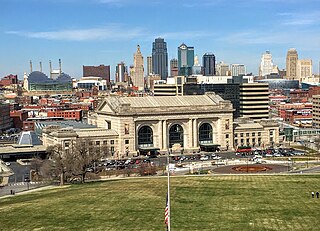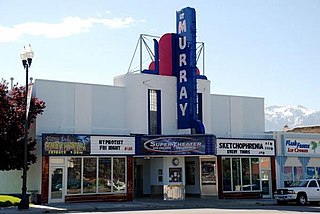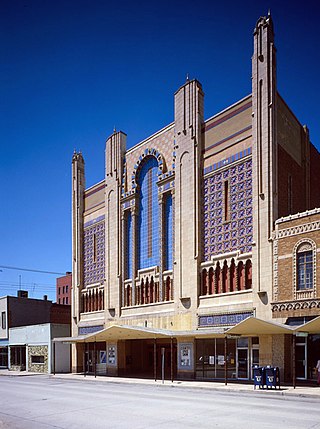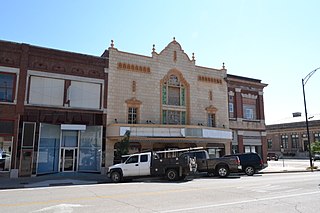
The Augusta Theater is a movie palace theater located in the city of Augusta, Kansas, which was built in about 1935. Designed by architect L. P. Larsen, the walls are decorated with large murals depicting classical scenes. It is significant, however, in that it was the first theater to use neon lighting exclusively. Considered to be a landmark of the Art Deco era, it became home of the Augusta Arts Council.

Downtown Kansas City is the central business district (CBD) of Kansas City, Missouri and the Kansas City metropolitan area which contains 3.8% of the areas employment. It is between the Missouri River in the north, to 31st Street in the south; and from the Kansas–Missouri state line eastward to Bruce R. Watkins Drive as defined by the Downtown Council of Kansas City; the 2010 Greater Downtown Area Plan formulated by the City of Kansas City defines the Greater Downtown Area to be the city limits of North Kansas City and Missouri to the north, the Kansas–Missouri state line to the west, 31st Street to the south and Woodland Avenue to the east. However, the definition used by the Downtown Council is the most commonly accepted.

The Hennepin Center for the Arts (HCA) is an art center in Minneapolis, Minnesota, United States. It occupies a building on Hennepin Avenue constructed in 1888 as a Masonic Temple. The building was designed by Long and Kees in the Richardsonian Romanesque architectural style. In 1978, it was purchased and underwent a renovation to become the HCA. Currently it is owned by Artspace Projects, Inc, and is home to more than 17 performing and visual art companies who reside on the building's eight floors. The eighth floor contains the Illusion Theater, which hosts many shows put on by companies in the building.

The Tulsa Theater is a theater and convention hall located in Tulsa, Oklahoma. It was originally completed in 1914 and remodeled in 1930 and 1952. The building was used as a detention center during the 1921 Tulsa race massacre. It is listed on the National Register of Historic Places and remains in use as a theater today. The theater was previously named after W. Tate Brady but was renamed in 2019 due to Brady's affiliation with the Ku Klux Klan.

Boller Brothers, often written Boller Bros., was an architectural firm based in Kansas City, Missouri which specialized in theater design in the Midwestern United States during the first half of the 20th century. Carl Heinrich Boller (1868–1946) and Robert Otto Boller (1887–1962) are credited with the design of almost 100 classic theaters ranging from small vaudeville venues to grand movie palaces.

The Murray Theater is a theater located in Murray, a suburb of Salt Lake City, Utah. It is listed on the National Register of Historic Places, and is one of the area's best examples of the Art Moderne style in theater architecture. The theater operated as both a first-run and second-run venue for motion pictures, and has been extensively renovated and redesigned during its history.

The Brown Grand Theatre is a community-based historical theatre located in Concordia, Kansas and is listed on the National Register of Historic Places. The theatre has been called "the most elegant theater between Kansas City and Denver" and to this day plays host to many popular events in the region.

The Missouri Theatre, is a concert and entertainment venue in downtown Columbia, Missouri, occupying most of a city block between 9th street between Locust and Elm Streets. It was designed after the Opéra Garnier by the Boller Brothers, built in 1928, and is on the National Register of Historic Places. It is Columbia's only surviving pre-Depression movie palace and vaudeville stage. In 2011, the University of Missouri began a three-year lease of the facility. The Missouri Theatre is the resident home of the Missouri Symphony Orchestra, and is also frequently used by University of Missouri and civic groups. As of July 1, 2014, The University of Missouri took over ownership of the Missouri Theatre. It is one of the main performance venues for the University of Missouri School of Music.

The Madam C. J. Walker Building, which houses the Madam Walker Legacy Center, was built in 1927 in the city of Indianapolis, in the U.S. state of Indiana, and as Madam C. J. Walker Manufacturing Company, it was designated a National Historic Landmark in 1991. The four-story, multi-purpose Walker Building was named in honor of Madam C. J. Walker, the African American hair care and beauty products entrepreneur who founded the Madam C. J. Walker Manufacturing Company, and designed by the Indianapolis architectural firm of Rubush & Hunter. The building served as the world headquarters for Walker's company, as well as entertainment, business, and commercial hub along Indiana Avenue for the city's African American community from the 1920s to the 1950s. The historic gathering place and venue for community events and arts and cultural programs were saved from demolition in the 1970s. The restored building, which includes African, Egyptian, and Moorish designs, is one of the few remaining African-Art Deco buildings in the United States. The Walker Building was added to the National Register of Historic Places in 1980.

The Carnegie Arts Center of Leavenworth, Kansas an historic building in namesake city. It was originally the Leavenworth Public Library. Constructed in 1900 with funds donated by Andrew Carnegie, the two-story brick and limestone building was the first Carnegie Library in Kansas. The architect was Marshall R. Sanguinet of Fort Worth, Texas, who designed the Dallas Public Library at the same time. It is listed on the State and National Registers of Historic Places.

The Granada Theater is a grand movie palace in Kansas City's historic downtown in Wyandotte County, Kansas. The theater is designed in the Mission style with Spanish and Moorish influences. Dominating the facade is a large Palladian window, flanked by terracotta pieces. Below the window is the main entrance, which centers on a glass ticket booth. The eastern and western ends of the facade's first floor are occupied by small storefronts.

The Standard Theatre, now known as the Folly Theater and also known as the Century Theater and Shubert's Missouri, is a former vaudeville hall in downtown Kansas City, Missouri. Built in 1900, it was designed by Kansas City architect Louis S. Curtiss. The theater was associated with the adjoining Edward Hotel, which was also designed by Curtiss; the hotel was demolished in 1965.

The Missouri Theater is a theater located in St. Joseph, Missouri. Completed in July 1927, the Missouri Theater was built as a cinema in the atmospheric style, using a combination of Art Deco and Moorish detailing.

The Tower Theatre for the Performing Arts is a historic Streamline Moderne mixed-use theater in Fresno, California. Built in 1939, it opened to the public on December 15, 1939, under the management of Fox West Coast Theater Corporation. The building was designed by S. Charles Lee, with its tower inspired by the "Star Pylon" at the 1939 New York World's Fair. The theater underwent a renovation and reopened as a performing arts center in 1990, after being closed as a repertory cinema in 1989 due to financial troubles.

The Mississippi Lofts and Adler Theatre is an apartment building and theater complex located in downtown Davenport, Iowa, United States. It is individually listed on the National Register of Historic Places by its original name, the Hotel Mississippi and RKO Orpheum Theater. The Hotel Mississippi was listed on the Davenport Register of Historic Properties in 2005. In 2020 the complex was included as a contributing property in the Davenport Downtown Commercial Historic District.

The Booth Theater is a historic movie theater located at 119 W. Myrtle St. in Independence, Kansas. The building was constructed in 1911 and renovated for use as a movie theater in 1926–27. The redesigned theater was the first in Independence to be designed specifically for use as a movie theater. The Boller Brothers, an architectural firm known for their theater designs, designed the theater in a mixture of the Spanish Renaissance and Italian Renaissance Revival styles. The theater showed films until its closure in 1980.

The Coleman Theatre is a historic performance venue and movie house located on historic U.S. Route 66 in Miami, Oklahoma. Built in 1929 for George Coleman, a local mining magnate, it has a distinctive Spanish Colonial Revival exterior, and an elaborate Louis XV interior. It was billed as the most elaborate theater between Dallas and Kansas City at the time of its opening, and played host to vaudeville acts, musical groups, and movies.

The Poncan Theatre is a historic theater in Ponca City, Oklahoma. It is individually listed on the National Register of Historic Places, and is a contributing property of the Downtown Ponca City Historic District.

Leavenworth Riverfront Community Center was a former Union Pacific railroad station located in Leavenworth, Kansas, United States. It is also known as the Old Union Depot when it was listed on the National Register of Historic Places (NRHP) in 1987. It is currently known as the Leavenworth Riverfront Community Center.

The Stiefel Theatre is in Salina, Kansas. Opened in 1931, it was listed on the National Register of Historic Places in 1988 as the "Fox–Watson Theater Building".






















